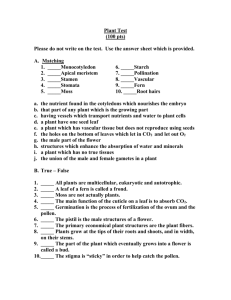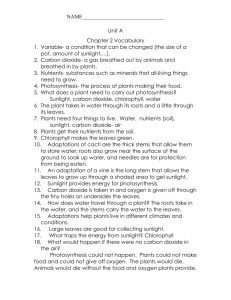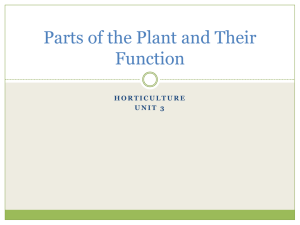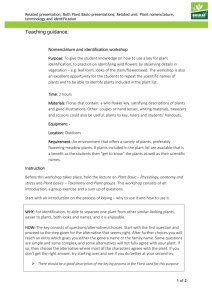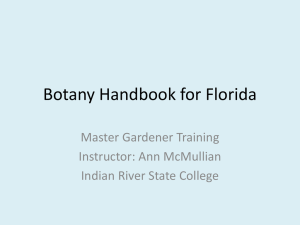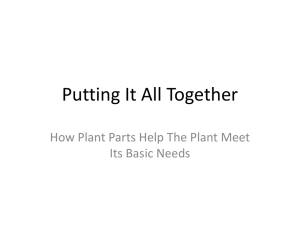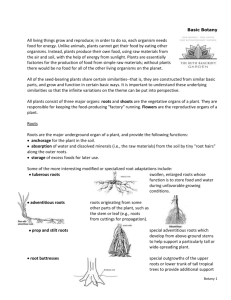AGSC 363
advertisement
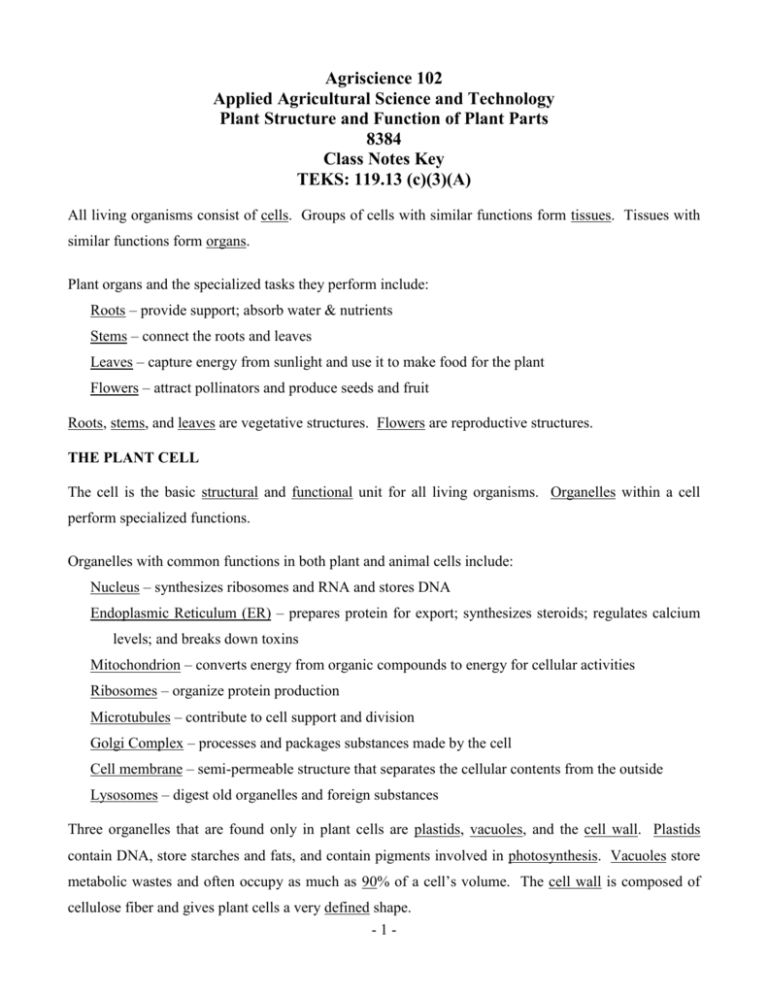
Agriscience 102 Applied Agricultural Science and Technology Plant Structure and Function of Plant Parts 8384 Class Notes Key TEKS: 119.13 (c)(3)(A) All living organisms consist of cells. Groups of cells with similar functions form tissues. Tissues with similar functions form organs. Plant organs and the specialized tasks they perform include: Roots – provide support; absorb water & nutrients Stems – connect the roots and leaves Leaves – capture energy from sunlight and use it to make food for the plant Flowers – attract pollinators and produce seeds and fruit Roots, stems, and leaves are vegetative structures. Flowers are reproductive structures. THE PLANT CELL The cell is the basic structural and functional unit for all living organisms. Organelles within a cell perform specialized functions. Organelles with common functions in both plant and animal cells include: Nucleus – synthesizes ribosomes and RNA and stores DNA Endoplasmic Reticulum (ER) – prepares protein for export; synthesizes steroids; regulates calcium levels; and breaks down toxins Mitochondrion – converts energy from organic compounds to energy for cellular activities Ribosomes – organize protein production Microtubules – contribute to cell support and division Golgi Complex – processes and packages substances made by the cell Cell membrane – semi-permeable structure that separates the cellular contents from the outside Lysosomes – digest old organelles and foreign substances Three organelles that are found only in plant cells are plastids, vacuoles, and the cell wall. Plastids contain DNA, store starches and fats, and contain pigments involved in photosynthesis. Vacuoles store metabolic wastes and often occupy as much as 90% of a cell’s volume. The cell wall is composed of cellulose fiber and gives plant cells a very defined shape. -1- PLANT TISSUE SYSTEMS A plant tissue is an organized mass made up of similar types of cells. Three classifications of tissues based on their origin, structure, and physiology are: dermal tissue, ground tissue, and vascular tissue. Dermal tissue forms the outer layer, or epidermis, of the plant. This type of tissue is responsible for a plant’s environmental interactions including light passage and gas exchange. In some types of plants, this tissue often has environmental adaptation features that regulate water loss from the plant and the exchange of carbon dioxide and oxygen from within the plant. Ground tissue consists of three types of cells that function in storage, metabolism, and support. Parenchyma cells have thin, primary cell walls and highly functional cytoplasm. These types of cells are the most common and abundant type of cells in plant tissues, making up the fleshy parts of fruits, roots, and tubers. Collenchyma cells are elongated cells with thick cell walls. These types of cells contain cellulose, which provides “flexible” support for plant stems and leaves. Sclerenchyma cells develop extensive secondary cell walls that contain lignin, suberin, and/or cutin. The longevity of these types of cells is short because the rigidity of their cell walls prevents them from exchanging the necessary components needed for active metabolism. Vascular tissues consist of xylem and phloem. Xylem consists of trachids and vessels, which function to conduct and transport water and minerals from the soil up through the plant. Phloem consists of sieve elements and companion cells, which function in the transport of sugars, amino acids, and other small molecules from the leaves to other parts of the plant. PLANT ORGANS Dermal, ground, and vascular tissues within a plant associate to form the plant’s organs, which include the roots, stems, leaves, and flowers. Roots are located mostly (above / below) the soil surface and represent about 50% of a plant’s weight. Roots function to absorb water and nutrients from the soil, support the plant in an upright position, and distribute food produced in the leaves to the growing areas of the roots. Based on the relative sizes of primary and secondary roots, classifications of root systems include taproot, fibrous, and adventitious. -2- Zones of root growth and differentiation include the: Meristem – area of active cell division and growth (root tip) Zone of elongation – nutrient and water absorption occurs causing cells to increase in size Zone of differentiation/maturation – cells undergo changes to become specific tissues (epidermis, cortex, and vascular tissue) Root hairs located along the main root form as an outgrowth of the epidermal cells. Their primary function is to absorb water and nutrients from the soil. The root cap, located at the outermost tip of a root, covers and protects the root’s growing region. It also directs root growth through the soil. A plant’s stems serve as supportive structures for the plant’s leaves. They also function in the transport of water and nutrients from the roots to the leaves and in the transport of food energy created in the leaves to other plant parts. The internal anatomy of a woody stem consists of: Xylem and phloem – to conduct water, nutrients, and food reserves Cambium – the site of cell division and active cell growth (meristematic tissue) Pith – the parenchyma layer at the center of a stem Structures making up the external anatomy of woody and herbaceous stems include: Terminal buds – growing points located at the tips of stems Axillary buds – growing points located in the leaf axils Node – the point of leaf attachment to the stem Internode – the area of the stem located between nodes Some plant stems have developed modifications for protection and to store additional food and water. Examples of above-ground stem modifications include thorns, prickles, stolons, spurs, pseudobulbs, and cladophylls. Rhizomes, tubers, corms, and bulbs are examples of below-ground stem modifications. The leaves on a plant function to capture sunlight for the plant processs of photosynthesis. Plant leaves contain stomata that allow for gas exchange and transpiration. The internal anatomy of a leaf consists of the: Cuticle – a thin film covering the outer layer of the leaf to protect it from excessive temperatures and water loss -3- Epidermis – cell layer on the upper and lower sides of a leaf that protects the inner cell layers and contains the guard cells to regulate stomatal opening and closing Mesophyll – innermost cell layers that contain the palisade parenchyma cells for photosynthesis and the spongy parenchyma cells for gas exchange The flat portion of a leaf is the leaf blade (or lamina). The petiole attaches it to the plant stem. Stipules located in the leaf axils function as food manufacturing structures. Flowers are the plant organs that function in plant reproduction. Flowers vary in size, structure, and composition among plant species. Parts of a complete flower include the: Calyx – leaf-like structures that form an outer ring around the base of a flower and function to enclose and protect the flower bud before it opens Corolla – often colorful and/or scented to attract specific pollinators to the flower Pistil – the female reproductive organs (stigma, style, ovary) Stamen – the male reproductive organs (anther, filament) Flower types based on the presence or absence of the four floral parts include: Perfect complete – contains all four floral parts Perfect incomplete – lacks only petals and/or sepals Incomplete – lacks one of the four floral parts Pistillate – has a pistil, but no stamens (imperfect incomplete flower) Staminate – has stamens, but no pistil (imperfect incomplete flower) Sterile – lacks both pistil and stamens A monoecious plant is one in which staminate and pistillate flowers exist on the same plant. Dioecious plants are those in which the male (staminate) and female (pistillate) flowers exit on completely separate plants. -4-

